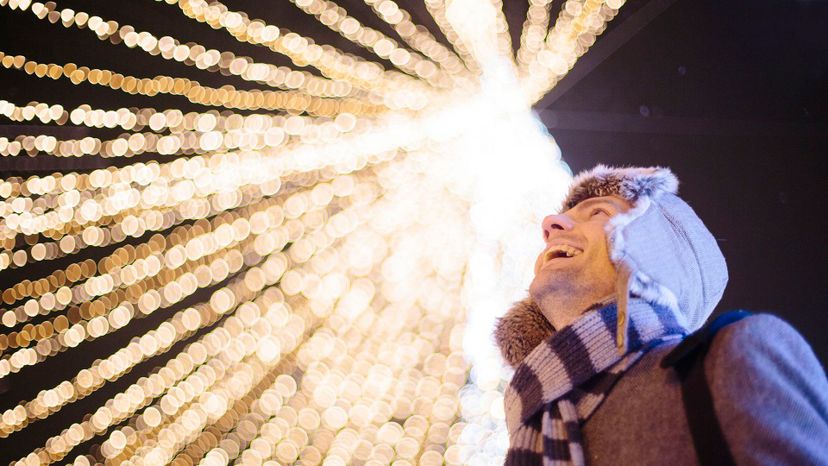
About This Quiz
Most everyone looks forward to seeing the colorful sparkle of Christmas lights at the end of every year. But how much do you really know about these seasonal displays? Find out by taking this quiz.President Calvin Coolidge hit the lights on the first national Christmas tree on the White House lawn in 1923.
In the Christmas season of 1880, Thomas Edison strung lights around his Menlo Park laboratory, which were the first electric Christmas lights ever put on display.
Candles were a dangerous way to decorate and caused many house fires during the Christmas season.
Advertisement
They may cost more to buy, but LED lights are brighter and cheaper to use than regular Christmas bulbs.
General Electric was the first company to sell Christmas lights to the public in 1903.
Inflatables -- nylon air-filled decorations that are powered by electric fans -- come in all sorts of characters and sizes. Inflatables aren't Christmas lights, but they often appear alongside elaborate light displays during the holiday season.
Advertisement
Mini lights actually use less power and are more energy efficient than larger bulbs.
Blow molds are plastic holiday decorations that light up and are popular items in outdoor Christmas displays.
In 1895, President Grover Cleveland wanted an electric Christmas display, so the White House Christmas tree was adorned with hundreds of multicolored bulbs.
Advertisement
A Christmas light contest can be as small as a competition between a few neighbors or as large as a town-wide celebration.
When candles were the decoration of choice, Christmas trees were a hazardous luxury. Families displayed them for just a few days and then discarded them, lest they become a terrible fire hazard.
Only the very wealthy could afford the first Christmas lights. Adjusting for inflation, a single strand cost about $300.
Advertisement
Bubble lights are filled with methylene chloride, a toxic solvent that may cause cancer. The chemical is so toxic that if one of the lights break, you should evacuate the area.
Many strands of lights rely on each light to complete the circuit. So if one bulb goes out, the rest of the lights do, too.
The first Christmas lights relied on incandescent light bulbs, the kind invented by Thomas Edison. For nearly a century, this technology dominated Christmas lights (and other electric lighting appliances, too).
Advertisement
Many lights come with a built-in fuse near (or in) the plug. Unplug the set and open the fuse compartment to see if the fuse is blown.
Before electricity, winters were even longer, and colder, and darker than they are now. In olden times, some groups would light a yule log at night, a way of beckoning (begging?) to the sun to return for the warmer, brighter season of spring.
Sure, the bigwigs of 1894 -- like Grover Cleveland -- had access to the magic of electricity…but hardly anyone else did. So the rest of America made do with candles, risking their lives for a bit of holiday cheer.
Advertisement
Longer strands of lights often have multiple circuits in parallel. So it's possible for one section to go out, while another section is still lit, making your house look like the tackiest home on the block.
In 1963, African Americans were incensed that no one would hire them as employees at businesses in downtown Greenville, NC. So they staged a major boycott, primarily refusing to buy Christmas lights.
Incandescent Christmas lights endure a beating in the outdoors, hammered by ultraviolet light and perhaps white-out blizzards. If you get three years out of them, you're doing well.
Advertisement
Johnson's first set of lights had a patriotic gleam. They were red, white…and blue.
The little red-tipped light is an added feature. If you want your lights to blink, you simply swap out a normal bulb and insert the red-tipped version.
The red-tipped blinker bulb is equipped with a temperature-sensitive circuit. When it warms up, it suddenly breaks the circuit. Then it cools off, and the circuit engages again. The effect? Blinking.
Advertisement
LED lights are more efficient than incandescent bulbs. They cost less to power, and they put off less heat, too.
Americans are crazy about Christmas lights. Each year, they unbox last year's lights, realize they don't work, and head out to buy more…to the tune of about 150 million strands.
Very few people could afford $12 for Christmas lights in the early 1900s. The solution? Some families would simply rent the lights (for less than $2), which meant they'd still have cash for a Christmas ham.
Advertisement
Americans love twinkling lights. About 80 million homes display Christmas lights, consuming perhaps 6% of the nation's electricity in December.
The first Christmas tree with electric lights was especially amazing. Not only did it feature lights, but it rotated on a motorized base, too. Then, the tree came to life and displayed homicidal urges, attempting to strangle passersby... and we probably made up that last part.
Mini bulbs are little lights that are the most common. C-9 bulbs are the really large bulbs, the biggest bulb that you can commonly buy at a big-box store.
Advertisement